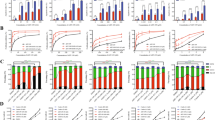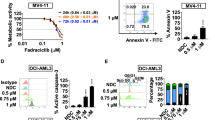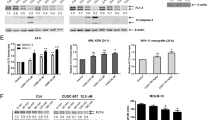Abstract
The canonical wingless-type MMTV integration site (WNT)-β-catenin pathway is essential for self-renewal, growth and survival of acute myeloid leukemia (AML) stem/blast progenitor cells (BPCs). Deregulated WNT signaling inhibits degradation of β-catenin, causing increased nuclear translocation and co-factor activity of β-catenin with the transcriptional regulator T-cell factor (TCF) 4/lymphoid enhancer factor 1 in AML BPCs. Here, we determined the pre-clinical anti-AML activity of the anthraquinone oxime-analog BC2059 (BC), known to attenuate β-catenin levels. BC treatment disrupted the binding of β-catenin with the scaffold protein transducin β-like 1 and proteasomal degradation and decline in the nuclear levels of β-catenin. This was associated with reduced transcriptional activity of TCF4 and expression of its target genes, cyclin D1, c-MYC and survivin. BC treatment dose-dependently induced apoptosis of cultured and primary AML BPCs. Treatment with BC also significantly improved the median survival of immune-depleted mice engrafted with either cultured or primary AML BPCs, exhibiting nuclear expression of β-catenin. Co-treatment with the pan-histone deacetylase inhibitor panobinostat and BC synergistically induced apoptosis of cultured and primary AML BPCs, including those expressing FLT3-ITD, as well as further significantly improved the survival of immune-depleted mice engrafted with primary AML BPCs. These findings underscore the promising pre-clinical activity and warrant further testing of BC against human AML, especially those expressing FLT3-ITD.
This is a preview of subscription content, access via your institution
Access options
Subscribe to this journal
Receive 12 print issues and online access
$259.00 per year
only $21.58 per issue
Buy this article
- Purchase on Springer Link
- Instant access to full article PDF
Prices may be subject to local taxes which are calculated during checkout







Similar content being viewed by others
Accession codes
References
Clevers H, Nusse R . Wnt/beta-catenin signaling and disease. Cell 2012; 149: 1192–1205.
Wang Y, Krivtsov AV, Sinha AU, North TE, Goessling W, Feng Z et al. The Wnt/beta-catenin pathway is required for the development of leukemia stem cells in AML. Science 2010; 327: 1650–1653.
Yeung J, Esposito MT, Gandillet A, Zeisig BB, Griessinger E, Bonnet D et al. beta-Catenin mediates the establishment and drug resistance of MLL leukemic stem cells. Cancer Cell 2010; 18: 606–618.
Lane SW, Wang YJ, Lo Celso C, Ragu C, Bullinger L, Sykes SM et al. Differential niche and Wnt requirements during acute myeloid leukemia progression. Blood 2011; 118: 2849–2856.
Petropoulos K, Arseni N, Schessl C, Stadler CR, Rawat VP, Deshpande AJ et al. A novel role for Lef-1, a central transcription mediator of Wnt signaling, in leukemogenesis. J Exp Med 2008; 205: 515–522.
Niehrs C . The complex world of WNT receptor signaling. Nat Rev Mol Cell Biol 2012; 13: 767–779.
Li W, Hou Y, Ming M, Yu L, Seba A, Qian Z . Apc regulates the function of hematopoietic stem cells largely through beta-catenin-dependent mechanisms. Blood 2013; 121: 4063–4072.
Li VS, Ng SS, Boersema PJ, Low TY, Karthaus WR, Gerlach JP et al. Wnt signaling through inhibition of beta-catenin degradation in an intact Axin1 complex. Cell 2012; 149: 1245–1256.
Thorne CA, Hanson AJ, Schneider J, Tahinci E, Orton D, Cselenyi CS et al. Small-molecule inhibition of Wnt signaling through activation of casein kinase 1alpha. Nat Chem Biol 2010; 6: 829–836.
Dimitrova YN, Li J, Lee YT, Rios-Esteves J, Friedman DB, Choi HJ et al. Direct ubiquitination of beta-catenin by Siah-1 and regulation by the exchange factor TBL1. J Biol Chem 2010; 285: 13507–13516.
Zhang N, Wei P, Gong A, Chiu WT, Lee HT, Colman H et al. FoxM1 promotes β-catenin nuclear localization and controls Wnt target-gene expression and glioma tumorigenesis. Cancer Cell 2011; 20: 427–442.
Xing Y, Takemaru K, Liu J, Berndt JD, Zheng JJ, Moon RT et al. Crystal structure of a full-length beta-catenin. Structure 2008; 16: 478–487.
Sampietro J, Dahlberg CL, Cho US, Hinds TR, Kimelman D, Xu W . Crystal structure of a beta-catenin/BCL9/Tcf4 complex. Mol Cell 2006; 24: 293–300.
Mo R, Chew TL, Maher MT, Bellipanni G, Weinberg ES, Gottardi CJ . The terminal region of beta-catenin promotes stability by shielding the Armadillo repeats from the axin-scaffold destruction complex. J Biol Chem 2009; 284: 28222–28231.
Mosimann C, Hausmann G, Basler K . Beta-catenin hits chromatin: regulation of Wnt target gene activation. Nat Rev Mol Cell Biol 2009; 10: 276–286.
Valencia A, Roman-Gomez J, Cervera J, Such E, Barragan E, Bolufer P et al. Wnt signaling pathway is epigenetically regulated by methylation of Wnt antagonists in acute myeloid leukemia. Leukemia 2009; 23: 1658–1666.
Kajiguchi T, Chung EJ, Lee S, Stine A, Kiyoi H, Naoe T et al. FLT3 regulates beta-catenin tyrosine phosphorylation, nuclear localization, and transcriptional activity in acute myeloid leukemia cells. Leukemia 2007; 21: 2476–2484.
Kajiguchi T, Katsumi A, Tanizaki R, Kiyoi H, Naoe T . Y654 of beta-catenin is essential for FLT3/ITD-related tyrosine phosphorylation and nuclear localization of beta-catenin. Eur J Haematol 2012; 88: 314–320.
Morgan RG, Pearn L, Liddiard K, Pumford SL, Burnett AK, Tonks A et al. γ-Catenin is overexpressed in acute myeloid leukemia and promotes the stabilization and nuclear localization of β-catenin. Leukemia 2013; 27: 336–343.
Jamieson CH, Ailles LE, Dylla SJ, Muijtjens M, Jones C, Zehnder JL et al N Engl J Med 2004; 351: 657–667.
Coluccia AM, Vacca A, Dunach M, Mologni L, Redaelli S, Bustos VH et al. Bcr-Abl stabilizes beta-catenin in chronic myeloid leukemia through its tyrosine phosphorylation. EMBO J 2007; 26: 1456–1466.
Jiang J, Griffin JD . Wnt/beta-catenin pathway modulates the sensitivity of the mutant FLT3 receptor kinase inhibitors in a GSK-3beta dependent manner. Genes Cancer 2010; 1: 164–176.
Perry JM, He XC, Sugimura R, Grindley JC, Haug JS, Ding S et al. Cooperation between both Wnt/{beta}-catenin and PTEN/PI3K/Akt signaling promotes primitive hematopoietic stem cell self-renewal and expansion. Genes Dev 2011; 25: 1928–1942.
Tenbaum SP, Ordonez-Moran P, Puig I, Chicote I, Arques O, Landolfi S et al. beta-catenin confers resistance to PI3K and AKT inhibitors and subverts FOXO3a to promote metastasis in colon cancer. Nat Med 2012; 18: 892–901.
Gehrke I, Gandhirajan RK, Kreuzer KA . Targeting the WNT/beta-catenin/TCF/LEF1 axis in solid and haematological cancers: Multiplicity of therapeutic options. Eur J Cancer 2009; 45: 2759–2767.
Minke KS, Staib P, Puetter A, Gehrke I, Gandhirajan RK, Schlosser A et al. Small molecule inhibitors of WNT signaling effectively induce apoptosis in acute myeloid leukemia cells. Eur J Haematol 2009; 82: 165–175.
Anastas JN, Moon RT . WNT signalling pathways as therapeutic targets in cancer. Nat Rev Cancer 2013; 13: 11–26.
Curtin JC, Lorenzi MV . Drug discovery approaches to target Wnt signaling in cancer stem cells. Oncotarget 2010; 1: 552–566.
Takahashi-Yanaga F, Kahn M . Targeting Wnt signaling: can we safely eradicate cancer stem cells? Clin Cancer Res 2010; 16: 3153–3162.
Li J, Wang CY . TBL1-TBLR1 and beta-catenin recruit each other to Wnt target-gene promoter for transcription activation and oncogenesis. Nat Cell Biol 2008; 10: 160–169.
Choi HK, Choi KC, Yoo JY, Song M, Ko SJ, Kim CH et al. Reversible SUMOylation of TBL1-TBLR1 regulates beta-catenin-mediated Wnt signaling. Mol Cell 2011; 43: 203–216.
Perissi V, Scafoglio C, Zhang J, Ohgi KA, Rose DW, Glass CK et al. TBL1 and TBLR1 phosphorylation on regulated gene promoters overcomes dual CtBP and NCoR/SMRT transcriptional repression checkpoints. Mol Cell 2008; 29: 755–766.
Oberoi J, Fairall L, Watson PJ, Yang JC, Czimmerer Z, Kampmann T et al. Structural basis for the assembly of the SMRT/NCoR core transcriptional repression machinery. Nat Struct Mol Biol 2011; 18: 177–184.
Ramadoss S, Li J, Ding X, Al Hezaimi K, Wang CY . Transducin beta-like protein 1 recruits nuclear factor kappaB to the target gene promoter for transcriptional activation. Mol Cell Biol 2011; 31: 924–934.
George P, Bali P, Annavarapu S, Scuto A, Fiskus W, Guo F et al. Combination of the histone deacetylase inhibitor LBH589 and the hsp90 inhibitor 17-AAG is highly active against human CML-BC cells and AML cells with activating mutation of FLT-3. Blood 2005; 105: 1768–1776.
Fiskus W, Wang Y, Sreekumar A, Buckley KM, Shi H, Jillella A et al. Combined epigenetic therapy with the histone methyltransferase EZH2 inhibitor 3-deazaneplanocin A and the histone deacetylase inhibitor panobinostat against human AML cells. Blood 2009; 114: 2733–2743.
Balusu R, Fiskus W, Rao R, Chong DG, Nalluri S, Mudunuru U et al. Targeting levels or oligomerization of nucleophosmin 1 induces differentiation and loss of survival of human AML cells with mutant NPM1. Blood 2011; 118: 3096–3106.
Fiskus W, Sharma S, Qi J, Valenta JA, Schaub LJ, Shah B et al. Highly active combination of BRD4 antagonist and histone deacetylase inhibitor against human acute myelogenous leukemia cells. Mol Cancer Ther 2014; 13: 1142–1154.
Fiskus W, Sharma S, Shah B, Portier BP, Devaraj SGT, Liu K et al. Highly effective combination of LSD1 (KDM1A) antagonist and pan-histone deacetylase inhibitor against human AML cells. Leukemia 2014; 28: 2155–2164.
Fiskus W, Saba N, Shen M, Ghias M, Das Gupta S, Chauhan L et al. Auranofin induces lethal oxidative and endoplasmic reticulum stress and exerts potent preclinical activity against chronic lymphocytic leukemia. Cancer Res 2014; 74: 2520–2532.
Shultz LD, Lyons BL, Burzenski LM, Gott B, Chen X, Chaleff S et al. Human lymphoid and myeloid cell development in NOD/LtSz-scid IL2R gamma null mice engrafted with mobilized human hemopoietic stem cells. J Immunol 2005; 174: 6477–6489.
Sanchez PV, Perry RL, Sarry JE, Perl AE, Murphy K, Swider CR et al. A robust xenotransplantation model for acute myeloid leukemia. Leukemia 2009; 23: 2109–2117.
Hoffmeyer K, Raggioli A, Rudloff S, Anton R, Hierholzer A, Del Valle I et al. Wnt/beta-catenin signaling regulates telomerase in stem cells and cancer cells. Science 2012; 336: 1549–1554.
Zhang Y, Toh L, Lau P, Wang X . Human telomerase reverse transcriptase (hTERT) is a novel target of the Wnt/beta-catenin pathway in human cancer. J Biol Chem 2012; 287: 32494–32511.
Siapati EK, Papadaki M, Kozaou Z, Rouka E, Michali E, Savvidou I et al. Proliferation and bone marrow engraftment of AML blasts is dependent on β-catenin signalling. Br J Haematol 2011; 152: 164–174.
Abrahamsson AE, Geron I, Gotlib J, Dao KH, Barroga CF, Newton IG et al. Glycogen synthase kinase 3beta missplicing contributes to leukemia stem cell generation. Proc Natl Acad Sci 2009; 106: 3925–3929.
Goentoro L, Kirschner MW . Evidence that fold-change, and not absolute level, of beta-catenin dictates Wnt signaling. Mol Cell 2009; 36: 872–884.
Noubissi FK, Goswami S, Sanek NA, Kawakami K, Minamoto T, Moser A et al. Wnt signaling stimulates transcriptional outcome of the Hedgehog pathway by stabilizing GLI1 mRNA. Cancer Res 2009; 69: 8572–8578.
Rosenbluh J, Nijhawan D, Cox AJ, Li X, Neal JT, Schafer EJ et al. β-Catenin-driven cancers require a YAP1 transcriptional complex for survival and tumorigenesis. Cell 2012; 151: 1457–1473.
Shimizu T, Kagawa T, Inoue T, Nonaka A, Takada S, Aburatani H et al. Stabilized beta-catenin functions through TCF/LEF proteins and the Notch/RBP-Jkappa complex to promote proliferation and suppress differentiation of neural precursor cells. Mol Cell Biol 2008; 28: 7427–7441.
Tsai BP, Hoverter NP, Waterman ML . Blending hippo and WNT: sharing messengers and regulation. Cell 2012; 151: 1401–1403.
Skokowa J, Lan D, Thakur BK, Wang F, Gupta K, Cario G et al. NAMPT is essential for the G-CSF-induced myeloid differentiation via a NAD(+)-sirtuin-1-dependent pathway. Nat Med 2009; 15: 151–158.
Tran T, Paz P, Velichko S, Cifrese J, Belur P, Yamaguchi KD et al. Interferonβ-1b induces the expression of RGS1 a negative regulator of G-protein signaling. Int J Cell Biol 2010; 2010: 529376.
Kode A, Manavalan JS, Mosialou I, Bhagat G, Rathinam CV, Luo N et al. Leukaemogenesis induced by an activating beta-catenin mutation in osteoblasts. Nature 2014; 506: 240–244.
Bradner JE, West N, Grachan ML, Greenberg EF, Haggarty SJ, Warnow T et al. Chemical phylogenetics of histone deacetylases. Nat Chem Biol 2010; 6: 238–243.
Zarrinkar PP, Gunawardane RN, Cramer MD, Gardner MF, Brigham D, Belli B et al. AC220 is a uniquely potent and selective inhibitor of FLT3 for the treatment of acute myeloid leukemia (AML). Blood 2009; 114: 2984–2992.
Smith CC, Lasater EA, Lin KC, Wang Q, McCreery MQ, Stewart WK et al. Crenolanib is a selective type I pan-FLT3 inhibitor. Proc Natl Acad Sci USA 2014; 111: 5319–5324.
Acknowledgements
This work was supported by a grant from the National Institutes of Health, National Cancer Institute (R01 CA173877) (K.N.B.).
Author information
Authors and Affiliations
Corresponding author
Ethics declarations
Competing interests
Stephan Horrigan is Chief Scientific Officer of β-Cat Pharma, Inc. The remaining authors declare no conflict of interest.
Additional information
Supplementary Information accompanies this paper on the Leukemia website
Rights and permissions
About this article
Cite this article
Fiskus, W., Sharma, S., Saha, S. et al. Pre-clinical efficacy of combined therapy with novel β-catenin antagonist BC2059 and histone deacetylase inhibitor against AML cells. Leukemia 29, 1267–1278 (2015). https://doi.org/10.1038/leu.2014.340
Received:
Revised:
Accepted:
Published:
Issue Date:
DOI: https://doi.org/10.1038/leu.2014.340
This article is cited by
-
Signaling pathways and their potential therapeutic utility in esophageal squamous cell carcinoma
Clinical and Translational Oncology (2022)
-
The Role of Pharmacotherapeutic Agents in Children with Desmoid Tumors
Pediatric Drugs (2022)
-
Wnt/β-catenin signaling in cancers and targeted therapies
Signal Transduction and Targeted Therapy (2021)
-
Inhibition of translation initiation factor eIF4a inactivates heat shock factor 1 (HSF1) and exerts anti-leukemia activity in AML
Leukemia (2021)
-
Desmoid Fibromatosis: Management in an Era of Increasing Options
Current Oncology Reports (2021)



